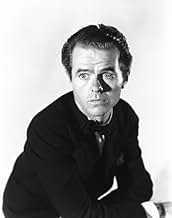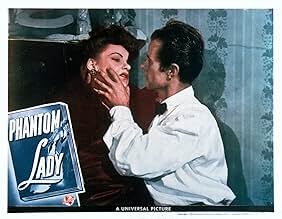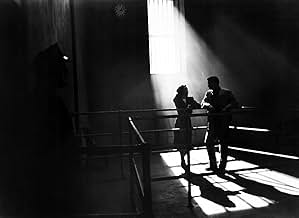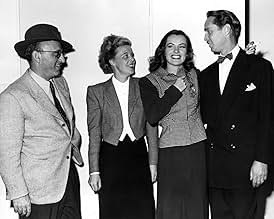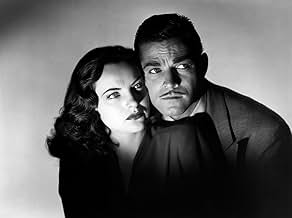IMDb RATING
7.2/10
6.3K
YOUR RATING
A devoted secretary risks her life to try to find the elusive woman who may prove her boss didn't murder his selfish wife.A devoted secretary risks her life to try to find the elusive woman who may prove her boss didn't murder his selfish wife.A devoted secretary risks her life to try to find the elusive woman who may prove her boss didn't murder his selfish wife.
- Director
- Writers
- Stars
Aurora Miranda
- Estela Monteiro
- (as Aurora)
Harry Adams
- Courtroom Spectator
- (uncredited)
Robert Bain
- Guitarist
- (uncredited)
Joan Bayley
- Dancer
- (uncredited)
Brandon Beach
- Theatre Party Guest
- (uncredited)
Brooks Benedict
- Theatre Party Guest
- (uncredited)
- Director
- Writers
- All cast & crew
- Production, box office & more at IMDbPro
Featured reviews
Film students and fans of film noir always hear about PHANTOM LADY and now that I've seen it I'm inclined to report that it's overrated. Though the premise is initially intriguing, it quickly accumulates so many plot holes that you instantly figure out who the murderer is. But this is an exercise in style, not content. Director Robert Siodmak saved the film by giving visual distinction to a poor script.
His training in the German Expressionist style makes for very striking images thoughout despite the low budget: dramatic contrasts between light and dark with simple, strong lighting effects never fail to provide interest and tension. And he goes a long way in suggesting the ethnic and racial mix of New York City in 1944 by his offbeat choice of extras and supporting players, most of whom are not the types you see in movies of the time. And the set of sculptor Franchot Tone's apartment complete with furniture and busts would be the envy of many a Soho or Tribeca resident in 2004.
In the lead, Ella Raines looks rather like a poor man's Gene Tierney. She is attractive and likable and you have no trouble maintaining interest in her, but she doesn't have much acting range, at least at this point in her career. Franchot Tone does a very professional job in an impossibly sketchy and ludicrous part, and Thomas Gomez is okay as the detective. As the wronged man, Alan Curtis provides his own visual interest via a strong jaw and broad shoulders, and an occasional hint of surliness makes his character more interesting.
But as others have indicated here, the single most surprising and effective scene is one where horny drummer Elisha Cook, Jr. takes Ella Raines to an after hours dive to show her what he's made of. Equating jazz and especially drumming with hot sex, Siodmak cross cuts between Cook's orgasmic frenzy at the drums (complete with a closeup insert of his crotch) with Ella seemingly transported as well, giving him the come-on, urging him to climax. It's the most overtly sexual scene I've ever seen in a '40s film and it's one you shouldn't miss.
His training in the German Expressionist style makes for very striking images thoughout despite the low budget: dramatic contrasts between light and dark with simple, strong lighting effects never fail to provide interest and tension. And he goes a long way in suggesting the ethnic and racial mix of New York City in 1944 by his offbeat choice of extras and supporting players, most of whom are not the types you see in movies of the time. And the set of sculptor Franchot Tone's apartment complete with furniture and busts would be the envy of many a Soho or Tribeca resident in 2004.
In the lead, Ella Raines looks rather like a poor man's Gene Tierney. She is attractive and likable and you have no trouble maintaining interest in her, but she doesn't have much acting range, at least at this point in her career. Franchot Tone does a very professional job in an impossibly sketchy and ludicrous part, and Thomas Gomez is okay as the detective. As the wronged man, Alan Curtis provides his own visual interest via a strong jaw and broad shoulders, and an occasional hint of surliness makes his character more interesting.
But as others have indicated here, the single most surprising and effective scene is one where horny drummer Elisha Cook, Jr. takes Ella Raines to an after hours dive to show her what he's made of. Equating jazz and especially drumming with hot sex, Siodmak cross cuts between Cook's orgasmic frenzy at the drums (complete with a closeup insert of his crotch) with Ella seemingly transported as well, giving him the come-on, urging him to climax. It's the most overtly sexual scene I've ever seen in a '40s film and it's one you shouldn't miss.
This isn't the best film noir but in a way it's quintessential in this way: I saw this years ago, and I have such a hazy memory that it's almost like I didn't see it... I think (?) It's the kind of movie I used to throw on really late at night like at 2 AM and I might watch all of it or some of it and then the rest the next day, and it has the kind of film noir plot and execution that it blends into many other film noirs. I don't mean to say that as a put down or to its detriment, but this fits so well into how this mood and feel work involving murder and a woman-who-wasn't-there (or seemingly never was) and a mystery to find the missing woman and all of the twists and turns therein.
It might be because it doesn't have the top shelf cast of some of the other movies of the period - there's no Barbara Stanwyck or Robert Mitchum or Edward G Robinson or Burt Lancaster or Glenn Ford or the list goes on - and yet I don't remember anyone here being so bad or off-putting that I had to turn it off or felt like I didn't get my VHS rental's worth. Siodmak's a quality director, and this is clearly the forerunner to what he would perfect with The Killers and Criss Cross. I'm sure I should see it again so I can solidify my opinion of it, but in a way I think it's fitting that it's half-forgotten - it's almost like the way that the characters find themselves in this story, a mystery to track down something buried away and not wanting to be found.
Or something.
It might be because it doesn't have the top shelf cast of some of the other movies of the period - there's no Barbara Stanwyck or Robert Mitchum or Edward G Robinson or Burt Lancaster or Glenn Ford or the list goes on - and yet I don't remember anyone here being so bad or off-putting that I had to turn it off or felt like I didn't get my VHS rental's worth. Siodmak's a quality director, and this is clearly the forerunner to what he would perfect with The Killers and Criss Cross. I'm sure I should see it again so I can solidify my opinion of it, but in a way I think it's fitting that it's half-forgotten - it's almost like the way that the characters find themselves in this story, a mystery to track down something buried away and not wanting to be found.
Or something.
Phantom Lady is quintessential Film Noir and a must-see for anyone who appreciates the genre. The film is not, nor does it aspire to be, a whodunit with an airtight plot, or a mystery-thriller that ends with an inconceivable twist as in the original novel. If that is what you want or expect, this is probably not your cup of tea. Although many great films considered part of the noir genre may include some of these elements, that's not what film noir is all about.
Film Noir is almost synonymous with Cornell Woolrich (William Irish), the author of the novel Phantom Lady. His novels and short stories are the source of an amazing number of screenplays and teleplays, including several noir and non-noir classics such as Hitchcock's Rear Window.
As a writer and persona, Woolrich was a uniquely noirish sort of guy. In fact, he wrote a series of six "Black" novels, all have been adapted to the screen or TV at least once, and some multiple times. Obviously, noir means black, and these black novels inspire great noir films.
Many Woolrich stories, Phantom Lady is one, revolve around impossible crimes. As sinister forces close in, his protagonists are powerless do anything but follow some diabolical labyrinth that defies understanding. No wonder his work is a perfect fit for film noir, which takes place in its own dark universe, where characters struggle against powerful and malevolent forces. Unfortunately, the nightmare scenarios created by Woolrich, enhanced by his own inimitable style of description, often seem to get lost in translation when brought to the silver screen. Although most of the films are very good, these adaptations tend to be very different from their literary source.
Not so with Phantom Lady – up to a point. Although details may vary, director Robert Siodmak cleverly and adroitly uses dazzling Expressionist visuals and quirky character performances to emulate the dreamlike quality of a Woolrich story. A good example is the incredible scene where Elisha Cook Jr. drums up the sexual overtones for Ella Raines.
Since our psychotic mastermind is revealed early on, there is no who-done-it mystery to distract the audience. The revelation allows a brilliant means of reworking the story into a tight and infinitely more interesting screenplay. Woolrich's original story follows a different approach, not confirming the killer until the end. Obviously, some treatments work better as a novel than a movie.
Often over-shadowed in the movies which he appears, this time Franchot Tone fits so perfectly into the role of Jack Marlow that we are captivated by his machinations, wondering where it will all end. All of the other characters are great and true to form as well. Raines is exceptionally strong in her portrayal of the somewhat naive love-struck secretary who won't give up.
True to a Woolrich novel, the genius of the film is in the telling of the story; more important than structure or even the ending. Although the outcome is the same, the ending is much different in the novel. Also, after the killer is revealed in the original story, there are 16 long pages, explaining every detail of every plot twist. Unfortunately, this approach is anticlimactic, and would never work as a film. Nevertheless, Siodmak is able to present a more convincing story with almost no explanation.
Any screen adaptation of a Woolrich story is always in jeopardy of being swallowed up by massive plot holes. After all, part of the charm of a Cornell Woolrich story is that you never really know if you dealing with reality, or trapped in a drug and alcohol induced nightmare.
In Phantom Lady, a character reveals, " I'd been blazing a reefer already before it happened, and you know what that does to you." Woolrich certainly did know, and much of his literature is obviously inspired by mind-bending experiences. If a screenwriter and director can artfully breach the massive plot chasms of an original Woolrich story, yet still preserve the beauty as in Phantom Lady, the film becomes a feast for any Film Noir fanatic.
Film Noir is almost synonymous with Cornell Woolrich (William Irish), the author of the novel Phantom Lady. His novels and short stories are the source of an amazing number of screenplays and teleplays, including several noir and non-noir classics such as Hitchcock's Rear Window.
As a writer and persona, Woolrich was a uniquely noirish sort of guy. In fact, he wrote a series of six "Black" novels, all have been adapted to the screen or TV at least once, and some multiple times. Obviously, noir means black, and these black novels inspire great noir films.
Many Woolrich stories, Phantom Lady is one, revolve around impossible crimes. As sinister forces close in, his protagonists are powerless do anything but follow some diabolical labyrinth that defies understanding. No wonder his work is a perfect fit for film noir, which takes place in its own dark universe, where characters struggle against powerful and malevolent forces. Unfortunately, the nightmare scenarios created by Woolrich, enhanced by his own inimitable style of description, often seem to get lost in translation when brought to the silver screen. Although most of the films are very good, these adaptations tend to be very different from their literary source.
Not so with Phantom Lady – up to a point. Although details may vary, director Robert Siodmak cleverly and adroitly uses dazzling Expressionist visuals and quirky character performances to emulate the dreamlike quality of a Woolrich story. A good example is the incredible scene where Elisha Cook Jr. drums up the sexual overtones for Ella Raines.
Since our psychotic mastermind is revealed early on, there is no who-done-it mystery to distract the audience. The revelation allows a brilliant means of reworking the story into a tight and infinitely more interesting screenplay. Woolrich's original story follows a different approach, not confirming the killer until the end. Obviously, some treatments work better as a novel than a movie.
Often over-shadowed in the movies which he appears, this time Franchot Tone fits so perfectly into the role of Jack Marlow that we are captivated by his machinations, wondering where it will all end. All of the other characters are great and true to form as well. Raines is exceptionally strong in her portrayal of the somewhat naive love-struck secretary who won't give up.
True to a Woolrich novel, the genius of the film is in the telling of the story; more important than structure or even the ending. Although the outcome is the same, the ending is much different in the novel. Also, after the killer is revealed in the original story, there are 16 long pages, explaining every detail of every plot twist. Unfortunately, this approach is anticlimactic, and would never work as a film. Nevertheless, Siodmak is able to present a more convincing story with almost no explanation.
Any screen adaptation of a Woolrich story is always in jeopardy of being swallowed up by massive plot holes. After all, part of the charm of a Cornell Woolrich story is that you never really know if you dealing with reality, or trapped in a drug and alcohol induced nightmare.
In Phantom Lady, a character reveals, " I'd been blazing a reefer already before it happened, and you know what that does to you." Woolrich certainly did know, and much of his literature is obviously inspired by mind-bending experiences. If a screenwriter and director can artfully breach the massive plot chasms of an original Woolrich story, yet still preserve the beauty as in Phantom Lady, the film becomes a feast for any Film Noir fanatic.
I'll admit that I like a certain degree of plausibility in films. Thus, it was hard for me to totally embrace this movie after watching the scene in which the husband (Alan Curtis) comes home to his darkened apartment and calls out for his wife, wondering where she is,unaware that detectives were there waiting for him. It was obvious that Curtis expected the wife to be home, not to mention alive, yet the detectives never took this into consideration. If you strangled your spouse, would you return home later and call out for her? Besides, who could have tipped off the detectives that a murder had occurred? OK, if you get by these sore spots, you'll find a well-made film noir that is worth watching.
Seldom have my expectations been as often derailed as in The Phantom Lady. The plot--while a bit farfetched--is never boring or predictable. Although it's a smaller film than say, The Maltese Falcon or The Big Sleep, it is immensely satisfying.
Ella Raines is the real stand-out here. Not only is she great to look at (think half-way between Veronica Lake and Lauren Bacall) she also acts circles 'round the two leading men. Luminous, expressive yet subtle, she is perhaps a better actress than those two icons, if slightly less perfect-looking than Lake and a bit less magnetic than Bacall.
Thomas Gomez turns in a surprisingly complex and interesting performance, but don't expect too much from Franchot Tone. Although his acting abilities need no defense, he didn't do much with this role.
Sure, there are plot holes, a couple of contrived turns, and at least two ridiculous performances (Elisha Cook and Aurora Miranda) but all B Noir has its faults, and this one wins by dint of its unpredictability and pacing, and some great cinematography. Oh--and miss Raines.
Ella Raines is the real stand-out here. Not only is she great to look at (think half-way between Veronica Lake and Lauren Bacall) she also acts circles 'round the two leading men. Luminous, expressive yet subtle, she is perhaps a better actress than those two icons, if slightly less perfect-looking than Lake and a bit less magnetic than Bacall.
Thomas Gomez turns in a surprisingly complex and interesting performance, but don't expect too much from Franchot Tone. Although his acting abilities need no defense, he didn't do much with this role.
Sure, there are plot holes, a couple of contrived turns, and at least two ridiculous performances (Elisha Cook and Aurora Miranda) but all B Noir has its faults, and this one wins by dint of its unpredictability and pacing, and some great cinematography. Oh--and miss Raines.
Did you know
- TriviaThe elusive phantom lady being sought by Carol "Kansas" Richman (Ella Raines), is repeatedly referenced as "Miss Terry" (i.e., "mystery").
- GoofsCliff's (Elisha Cook Jr.) "drumming" at no time matches the drums on the soundtrack.
- Quotes
Cliff: You and I are going to have fun tonight, Jeannie! You like jive?
Carol Richman: You bet! I'm a hep kitten!
- ConnectionsFeatured in Les Experts: A Night at the Movies (2003)
- SoundtracksI'll Remember April
(uncredited)
Music by Gene de Paul
Lyrics by Patricia Johnston & Don Raye
[played during opening credits and throughout the movie]
- How long is Phantom Lady?Powered by Alexa
Details
- Runtime
- 1h 27m(87 min)
- Color
- Aspect ratio
- 1.33 : 1
Contribute to this page
Suggest an edit or add missing content


